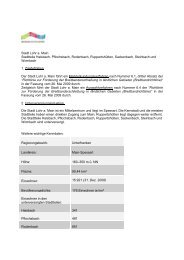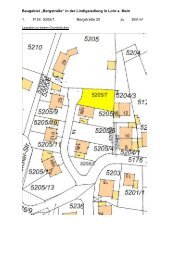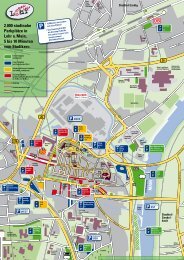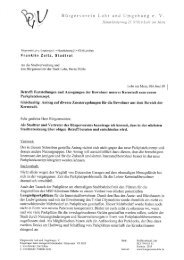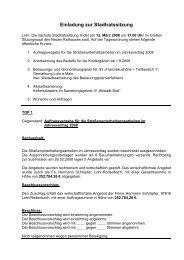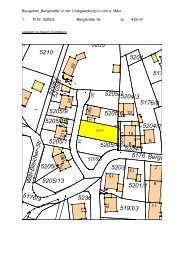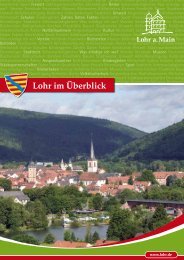Snow White - Lohr a. Main
Snow White - Lohr a. Main
Snow White - Lohr a. Main
Create successful ePaper yourself
Turn your PDF publications into a flip-book with our unique Google optimized e-Paper software.
<strong>Snow</strong> <strong>White</strong> – a native girl from <strong>Lohr</strong> am <strong>Main</strong><br />
In 1986 the pharmacist and historian Dr. Karlheinz Bartels of <strong>Lohr</strong> am<br />
<strong>Main</strong>, Germany, succeeded in credibly connecting many of the actual<br />
points of reference of the fairytale to <strong>Lohr</strong> and the surrounding region 1 .<br />
According to this theory, the historical prototype of <strong>Snow</strong> <strong>White</strong> was born<br />
Maria Sophia Margaretha Catharina von Erthal in <strong>Lohr</strong> am <strong>Main</strong> in the year<br />
1729. Her father, Philipp Christoph von Erthal, was the superior<br />
magistrate representing the Electorate of <strong>Main</strong>z in <strong>Lohr</strong> between 1719<br />
and 1748. Due to his diplomatic skills, the father was frequently away<br />
from home as an ambassador and “foreign minister” for the<br />
archbishopric. In that capacity he had dealings with emperors and kings<br />
throughout Europe. For this reason, the von Erthals may have appeared to<br />
the inhabitants of <strong>Lohr</strong> as a sort of “royal family.”<br />
The castle in <strong>Lohr</strong> was the family’s official residence. After the death of<br />
Maria Sophia’s birth mother in the year 1741, her father married Claudia<br />
Elisabeth Maria von Venningen, born the imperial countess of<br />
Reichenstein, on May 15, 1743. The stepmother was demonstrably<br />
domineering, and employed her position –Philipp Christoph was very<br />
rarely at home in <strong>Lohr</strong> – to the advantage of her children from her first<br />
marriage. The frequent absence of the father might well explain (in the<br />
words of Theodor Ruf) the “oddly inactive” role of the king within the<br />
fairytale 2 .<br />
The most important clue to support the idea that <strong>Snow</strong> <strong>White</strong> was a native<br />
of <strong>Lohr</strong> is the “Talking Mirror.” This magic mirror, 1.6 meters in height<br />
and ornately decorated, can still be viewed today in the Spessart Museum<br />
in the <strong>Lohr</strong> Castle. It has been proven to be a product of the Mirror<br />
Manufacture of the Electorate of <strong>Main</strong>z (Kurmainzische<br />
Spiegelmanufaktur) 3 . The Mirror Manufacture was famous throughout<br />
1<br />
Karlheinz Bartels: Schneewittchen – Zur Fabulologie des Spessarts. <strong>Lohr</strong> 1990, ISBN 3-<br />
9800281-4-3.<br />
2<br />
Theodor Ruf: Die Schöne aus dem Glassarg. Schneewittchens märchenhaftes und wirkliches<br />
Leben. Würzburg: Königshausen und Neumann, 1994, ISBN 3-88479-967-3 p.66<br />
3<br />
Werner Loibl, Die kurmainzische Spiegelmanufaktur <strong>Lohr</strong> am <strong>Main</strong> (1698 – 1806) und die<br />
Nachfolgebetriebe im Spessart, Neustadt an der Aisch 2012 (in print); Loibl is the foremost expert in the<br />
history of 17th- and 18th-century glasshouses in Germany, according to Dedo von Kerssenbrock-Krosigk,<br />
Curator of European Glass at the Corning Museum of Glass (Corning, NY).
Europe. It was founded in <strong>Lohr</strong> in 1698 by the electoral prince Lothar<br />
Franz von Schönborn. This firm was controlled by Philipp Christoph von<br />
Erthal. The mirror was likely a gift from him to his second wife Claudia. It<br />
“spoke”, like many mirrors from <strong>Lohr</strong>, predominantly in aphorisms. The<br />
upper right corner of the mirror contains a clear reference to self-love<br />
(“Amour Propre”).<br />
Geographical points of reference can also be found in the vicinity of <strong>Lohr</strong>.<br />
The “wild woods” (for all quotations cf. the English text translated by D.L.<br />
Ashliman) in which <strong>Snow</strong> <strong>White</strong> was abandoned could be the Spessart,<br />
which Wilhelm Hauff (1802-1827) later characterized in The Inn in the<br />
Spessart as a “terrible forest” 4 . <strong>Snow</strong> <strong>White</strong>’s escape route across “the<br />
mountains” was perhaps an allusion to an ancient mountainous route,<br />
which was already referenced in the fourteenth century and on which it<br />
was possible from <strong>Lohr</strong> to reach the mines near Bieber via the Spessart<br />
Mountains. In the middle of the eighteenth century approximately 500<br />
miners were employed there digging for silver and copper. It is possible<br />
that the “seven dwarfs who picked and dug for ore in the mountains”<br />
were diminutive miners or children working in those mines. Bartels was<br />
likewise able to designate relevant literature describing the substance<br />
with which the evil stepmother possibly produced the “poisoned apple”:<br />
according to this theory, she saturated half of the apple with the juice of<br />
the legendary Atropa belladonna/Black Cherry 5 . This plant is also<br />
indigenous to the Spessart. Its berries contain the alkaloid atropine,<br />
which has an anesthetic effect and which may have produced <strong>Snow</strong><br />
<strong>White</strong>’s rigor mortis.<br />
The “glass coffin” and the “pair of iron shoes,” in which the stepmother<br />
“was forced … to dance until she fell down dead” as punishment, could<br />
readily have been manufactured in the glassworks or hammer mills of the<br />
Spessart region.<br />
It was the people of <strong>Lohr</strong> who transformed Maria Sophia, on the basis of<br />
her praiseworthy virtues, into nothing less than a fairytale figure. M.B.<br />
Kittel, the chronicler of the Erthal family, characterized Maria Sophia as a<br />
noble girl, an “angel of mercy and kindness,” and as “charitable toward<br />
the poor and the suffering”; he attributed to her a “personal amiability.”<br />
In the “hearts and minds of the people,” namely the population of <strong>Lohr</strong><br />
4<br />
5<br />
Cf. the text online in: http://www.readbookonline.net/readOnLine/47123/.<br />
Cf. http://botanical.com/botanical/mgmh/n/nighde05.html
and the Spessart, this daughter of the Erthal family probably represented<br />
the ideal image of a princess. Within a few years of the death of Maria<br />
Sophia the story was already put to paper, and in late 1812 the fairytale<br />
<strong>Snow</strong> <strong>White</strong> was first published by the Brothers Grimm.<br />
|The birthplace of Maria Sophia<br />
Margaretha Catharina von Erthal<br />
(<strong>Snow</strong> <strong>White</strong>): the Castle in <strong>Lohr</strong><br />
am <strong>Main</strong> in the county of <strong>Main</strong>-<br />
Spessart, Germany, nowadays<br />
location of the Spessart ;<br />
Foto: Barbara Grimm<br />
The “Talking Mirror” in the<br />
Spessart Museum in <strong>Lohr</strong> am<br />
<strong>Main</strong>; Foto: Manfred Scherer






